Clinical Reflection Report: Podiatric Management Plan and Analysis
VerifiedAdded on 2023/06/03
|7
|1610
|467
Report
AI Summary
This clinical reflection report presents a detailed analysis of a podiatric case involving a 47-year-old male patient with a complex medical history, including type-2 diabetes, diabetic neuropathy, and a history of smoking. The report, guided by ANZPAC guidelines, focuses on developing a patient-centered management plan. The student reflects on the patient's presentation, including physical and psychosocial considerations such as the patient's occupation as a truck driver, his partner's illness, and the patient's lack of health awareness. The report outlines short-term and long-term treatment plans, including wound management strategies, education on hygiene, and referrals for specialized care. It also discusses the importance of patient education, nutritional plans, and mental health support to improve the patient's overall health and well-being. The report also includes a podiatric management plan that addresses various aspects of patient care, from discussing the plan with the patient to identifying and mitigating risks associated with the patient's condition, such as the patient's unwillingness to wear shoes. The report concludes with a comprehensive list of references.
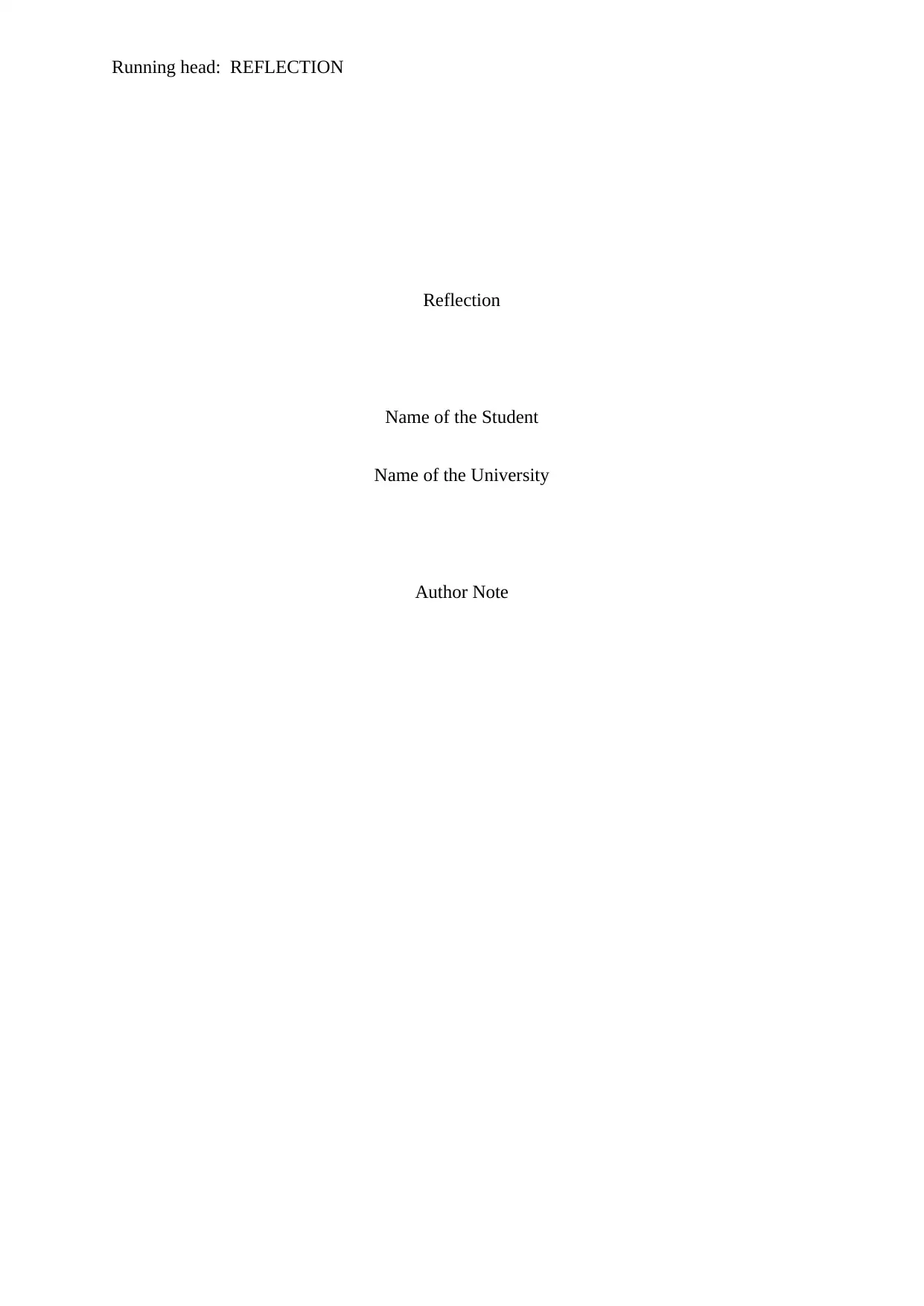
Running head: REFLECTION
Reflection
Name of the Student
Name of the University
Author Note
Reflection
Name of the Student
Name of the University
Author Note
Paraphrase This Document
Need a fresh take? Get an instant paraphrase of this document with our AI Paraphraser
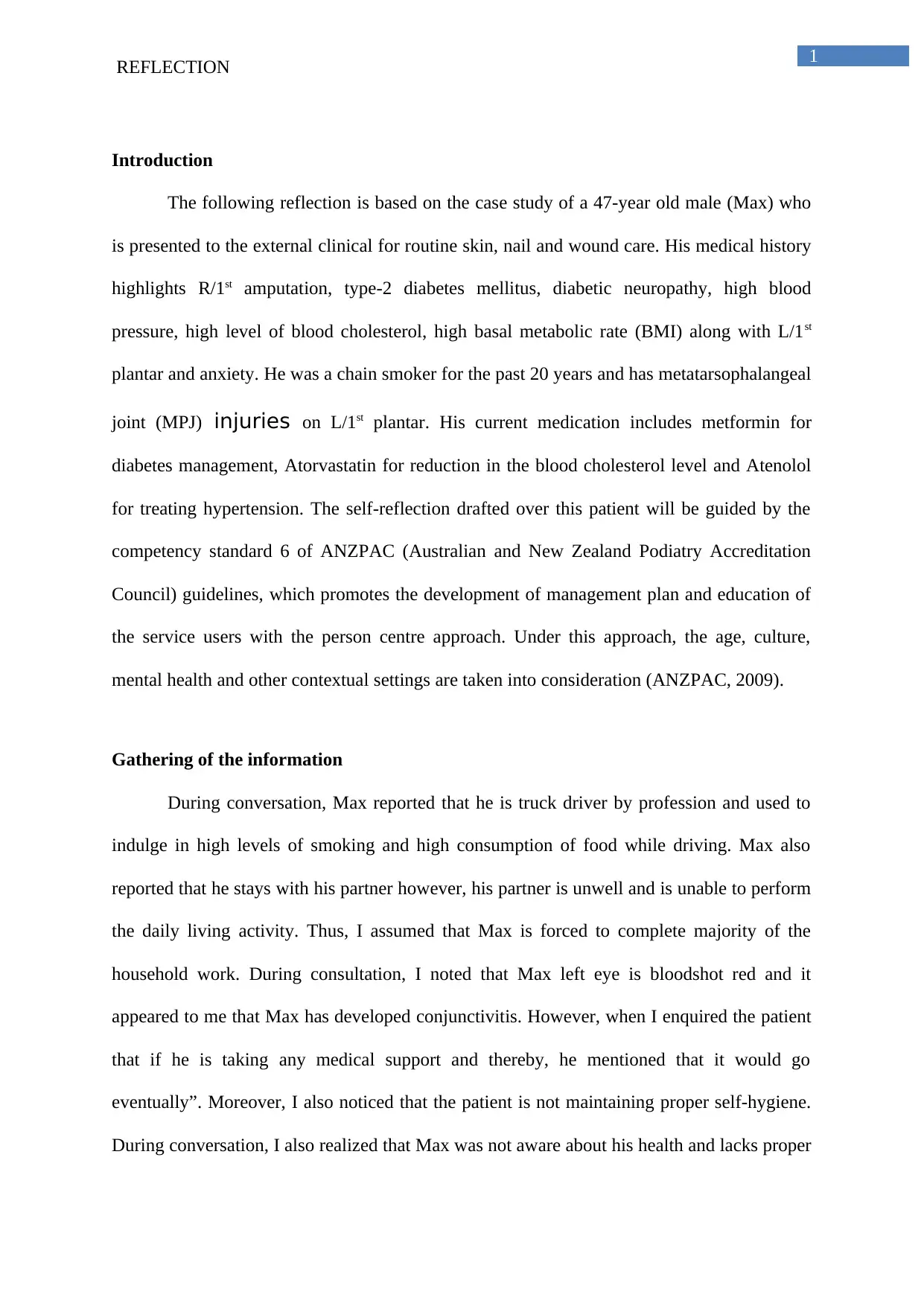
1
REFLECTION
Introduction
The following reflection is based on the case study of a 47-year old male (Max) who
is presented to the external clinical for routine skin, nail and wound care. His medical history
highlights R/1st amputation, type-2 diabetes mellitus, diabetic neuropathy, high blood
pressure, high level of blood cholesterol, high basal metabolic rate (BMI) along with L/1st
plantar and anxiety. He was a chain smoker for the past 20 years and has metatarsophalangeal
joint (MPJ) injuries on L/1st plantar. His current medication includes metformin for
diabetes management, Atorvastatin for reduction in the blood cholesterol level and Atenolol
for treating hypertension. The self-reflection drafted over this patient will be guided by the
competency standard 6 of ANZPAC (Australian and New Zealand Podiatry Accreditation
Council) guidelines, which promotes the development of management plan and education of
the service users with the person centre approach. Under this approach, the age, culture,
mental health and other contextual settings are taken into consideration (ANZPAC, 2009).
Gathering of the information
During conversation, Max reported that he is truck driver by profession and used to
indulge in high levels of smoking and high consumption of food while driving. Max also
reported that he stays with his partner however, his partner is unwell and is unable to perform
the daily living activity. Thus, I assumed that Max is forced to complete majority of the
household work. During consultation, I noted that Max left eye is bloodshot red and it
appeared to me that Max has developed conjunctivitis. However, when I enquired the patient
that if he is taking any medical support and thereby, he mentioned that it would go
eventually”. Moreover, I also noticed that the patient is not maintaining proper self-hygiene.
During conversation, I also realized that Max was not aware about his health and lacks proper
REFLECTION
Introduction
The following reflection is based on the case study of a 47-year old male (Max) who
is presented to the external clinical for routine skin, nail and wound care. His medical history
highlights R/1st amputation, type-2 diabetes mellitus, diabetic neuropathy, high blood
pressure, high level of blood cholesterol, high basal metabolic rate (BMI) along with L/1st
plantar and anxiety. He was a chain smoker for the past 20 years and has metatarsophalangeal
joint (MPJ) injuries on L/1st plantar. His current medication includes metformin for
diabetes management, Atorvastatin for reduction in the blood cholesterol level and Atenolol
for treating hypertension. The self-reflection drafted over this patient will be guided by the
competency standard 6 of ANZPAC (Australian and New Zealand Podiatry Accreditation
Council) guidelines, which promotes the development of management plan and education of
the service users with the person centre approach. Under this approach, the age, culture,
mental health and other contextual settings are taken into consideration (ANZPAC, 2009).
Gathering of the information
During conversation, Max reported that he is truck driver by profession and used to
indulge in high levels of smoking and high consumption of food while driving. Max also
reported that he stays with his partner however, his partner is unwell and is unable to perform
the daily living activity. Thus, I assumed that Max is forced to complete majority of the
household work. During consultation, I noted that Max left eye is bloodshot red and it
appeared to me that Max has developed conjunctivitis. However, when I enquired the patient
that if he is taking any medical support and thereby, he mentioned that it would go
eventually”. Moreover, I also noticed that the patient is not maintaining proper self-hygiene.
During conversation, I also realized that Max was not aware about his health and lacks proper
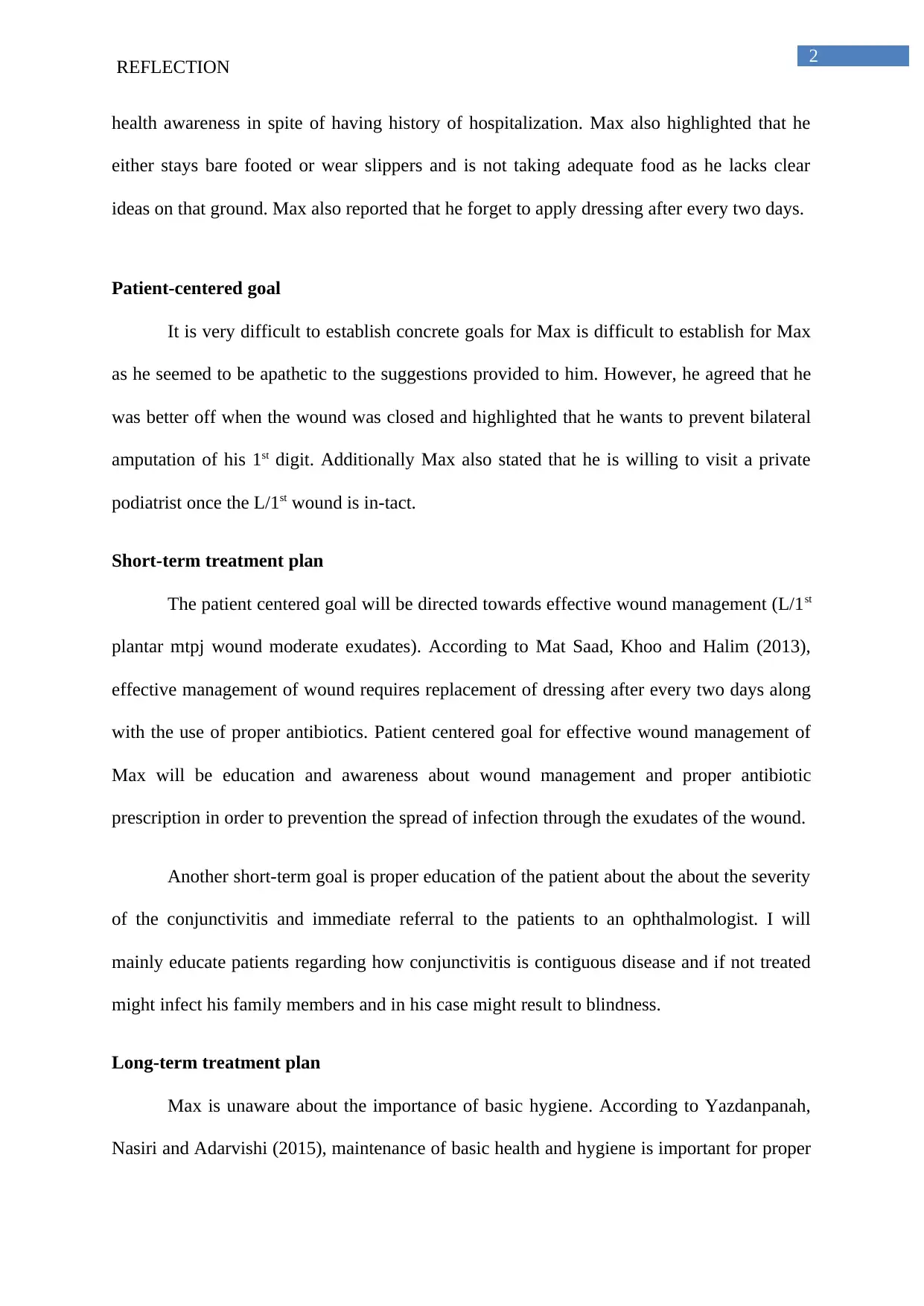
2
REFLECTION
health awareness in spite of having history of hospitalization. Max also highlighted that he
either stays bare footed or wear slippers and is not taking adequate food as he lacks clear
ideas on that ground. Max also reported that he forget to apply dressing after every two days.
Patient-centered goal
It is very difficult to establish concrete goals for Max is difficult to establish for Max
as he seemed to be apathetic to the suggestions provided to him. However, he agreed that he
was better off when the wound was closed and highlighted that he wants to prevent bilateral
amputation of his 1st digit. Additionally Max also stated that he is willing to visit a private
podiatrist once the L/1st wound is in-tact.
Short-term treatment plan
The patient centered goal will be directed towards effective wound management (L/1st
plantar mtpj wound moderate exudates). According to Mat Saad, Khoo and Halim (2013),
effective management of wound requires replacement of dressing after every two days along
with the use of proper antibiotics. Patient centered goal for effective wound management of
Max will be education and awareness about wound management and proper antibiotic
prescription in order to prevention the spread of infection through the exudates of the wound.
Another short-term goal is proper education of the patient about the about the severity
of the conjunctivitis and immediate referral to the patients to an ophthalmologist. I will
mainly educate patients regarding how conjunctivitis is contiguous disease and if not treated
might infect his family members and in his case might result to blindness.
Long-term treatment plan
Max is unaware about the importance of basic hygiene. According to Yazdanpanah,
Nasiri and Adarvishi (2015), maintenance of basic health and hygiene is important for proper
REFLECTION
health awareness in spite of having history of hospitalization. Max also highlighted that he
either stays bare footed or wear slippers and is not taking adequate food as he lacks clear
ideas on that ground. Max also reported that he forget to apply dressing after every two days.
Patient-centered goal
It is very difficult to establish concrete goals for Max is difficult to establish for Max
as he seemed to be apathetic to the suggestions provided to him. However, he agreed that he
was better off when the wound was closed and highlighted that he wants to prevent bilateral
amputation of his 1st digit. Additionally Max also stated that he is willing to visit a private
podiatrist once the L/1st wound is in-tact.
Short-term treatment plan
The patient centered goal will be directed towards effective wound management (L/1st
plantar mtpj wound moderate exudates). According to Mat Saad, Khoo and Halim (2013),
effective management of wound requires replacement of dressing after every two days along
with the use of proper antibiotics. Patient centered goal for effective wound management of
Max will be education and awareness about wound management and proper antibiotic
prescription in order to prevention the spread of infection through the exudates of the wound.
Another short-term goal is proper education of the patient about the about the severity
of the conjunctivitis and immediate referral to the patients to an ophthalmologist. I will
mainly educate patients regarding how conjunctivitis is contiguous disease and if not treated
might infect his family members and in his case might result to blindness.
Long-term treatment plan
Max is unaware about the importance of basic hygiene. According to Yazdanpanah,
Nasiri and Adarvishi (2015), maintenance of basic health and hygiene is important for proper
⊘ This is a preview!⊘
Do you want full access?
Subscribe today to unlock all pages.

Trusted by 1+ million students worldwide
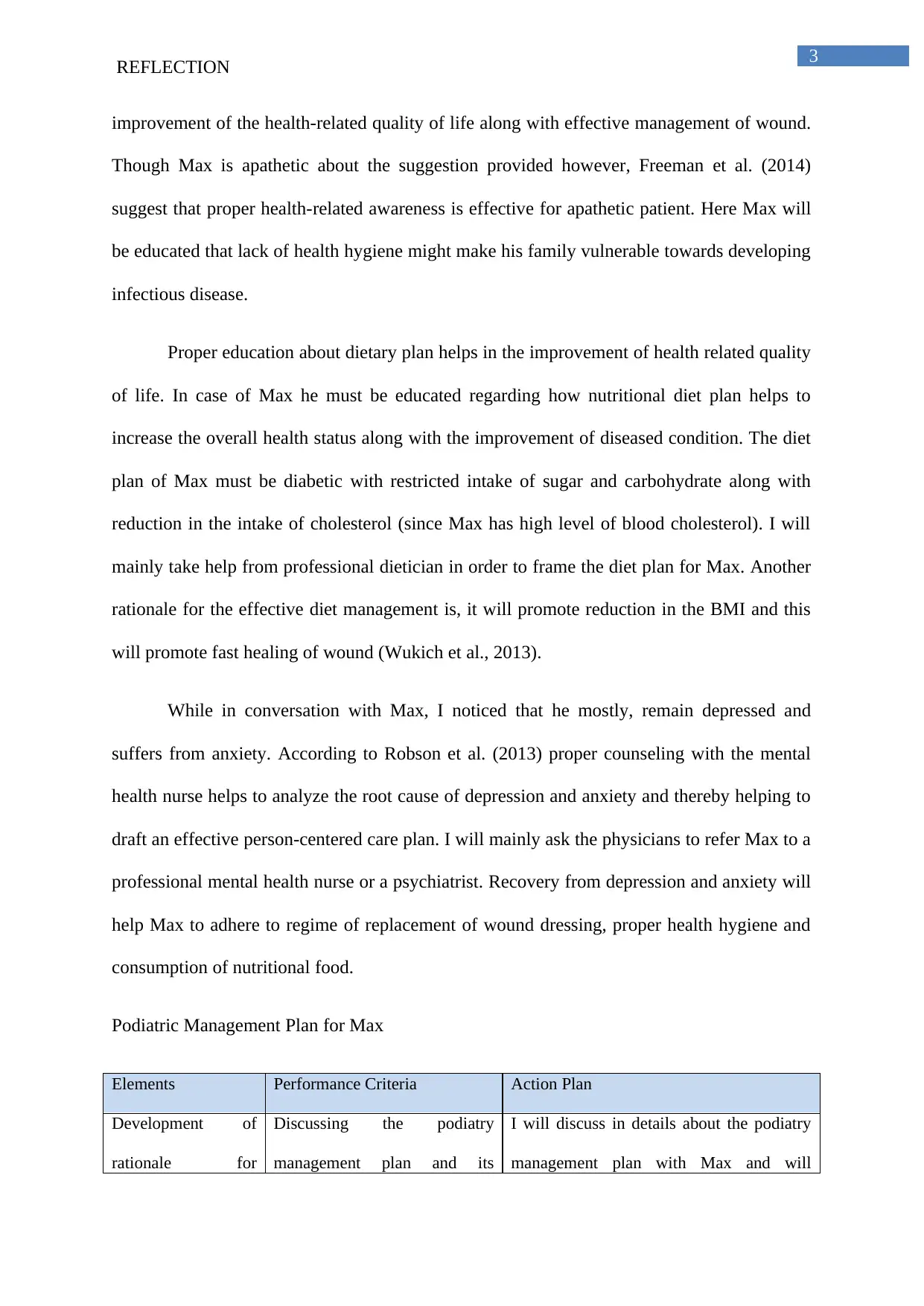
3
REFLECTION
improvement of the health-related quality of life along with effective management of wound.
Though Max is apathetic about the suggestion provided however, Freeman et al. (2014)
suggest that proper health-related awareness is effective for apathetic patient. Here Max will
be educated that lack of health hygiene might make his family vulnerable towards developing
infectious disease.
Proper education about dietary plan helps in the improvement of health related quality
of life. In case of Max he must be educated regarding how nutritional diet plan helps to
increase the overall health status along with the improvement of diseased condition. The diet
plan of Max must be diabetic with restricted intake of sugar and carbohydrate along with
reduction in the intake of cholesterol (since Max has high level of blood cholesterol). I will
mainly take help from professional dietician in order to frame the diet plan for Max. Another
rationale for the effective diet management is, it will promote reduction in the BMI and this
will promote fast healing of wound (Wukich et al., 2013).
While in conversation with Max, I noticed that he mostly, remain depressed and
suffers from anxiety. According to Robson et al. (2013) proper counseling with the mental
health nurse helps to analyze the root cause of depression and anxiety and thereby helping to
draft an effective person-centered care plan. I will mainly ask the physicians to refer Max to a
professional mental health nurse or a psychiatrist. Recovery from depression and anxiety will
help Max to adhere to regime of replacement of wound dressing, proper health hygiene and
consumption of nutritional food.
Podiatric Management Plan for Max
Elements Performance Criteria Action Plan
Development of
rationale for
Discussing the podiatry
management plan and its
I will discuss in details about the podiatry
management plan with Max and will
REFLECTION
improvement of the health-related quality of life along with effective management of wound.
Though Max is apathetic about the suggestion provided however, Freeman et al. (2014)
suggest that proper health-related awareness is effective for apathetic patient. Here Max will
be educated that lack of health hygiene might make his family vulnerable towards developing
infectious disease.
Proper education about dietary plan helps in the improvement of health related quality
of life. In case of Max he must be educated regarding how nutritional diet plan helps to
increase the overall health status along with the improvement of diseased condition. The diet
plan of Max must be diabetic with restricted intake of sugar and carbohydrate along with
reduction in the intake of cholesterol (since Max has high level of blood cholesterol). I will
mainly take help from professional dietician in order to frame the diet plan for Max. Another
rationale for the effective diet management is, it will promote reduction in the BMI and this
will promote fast healing of wound (Wukich et al., 2013).
While in conversation with Max, I noticed that he mostly, remain depressed and
suffers from anxiety. According to Robson et al. (2013) proper counseling with the mental
health nurse helps to analyze the root cause of depression and anxiety and thereby helping to
draft an effective person-centered care plan. I will mainly ask the physicians to refer Max to a
professional mental health nurse or a psychiatrist. Recovery from depression and anxiety will
help Max to adhere to regime of replacement of wound dressing, proper health hygiene and
consumption of nutritional food.
Podiatric Management Plan for Max
Elements Performance Criteria Action Plan
Development of
rationale for
Discussing the podiatry
management plan and its
I will discuss in details about the podiatry
management plan with Max and will
Paraphrase This Document
Need a fresh take? Get an instant paraphrase of this document with our AI Paraphraser
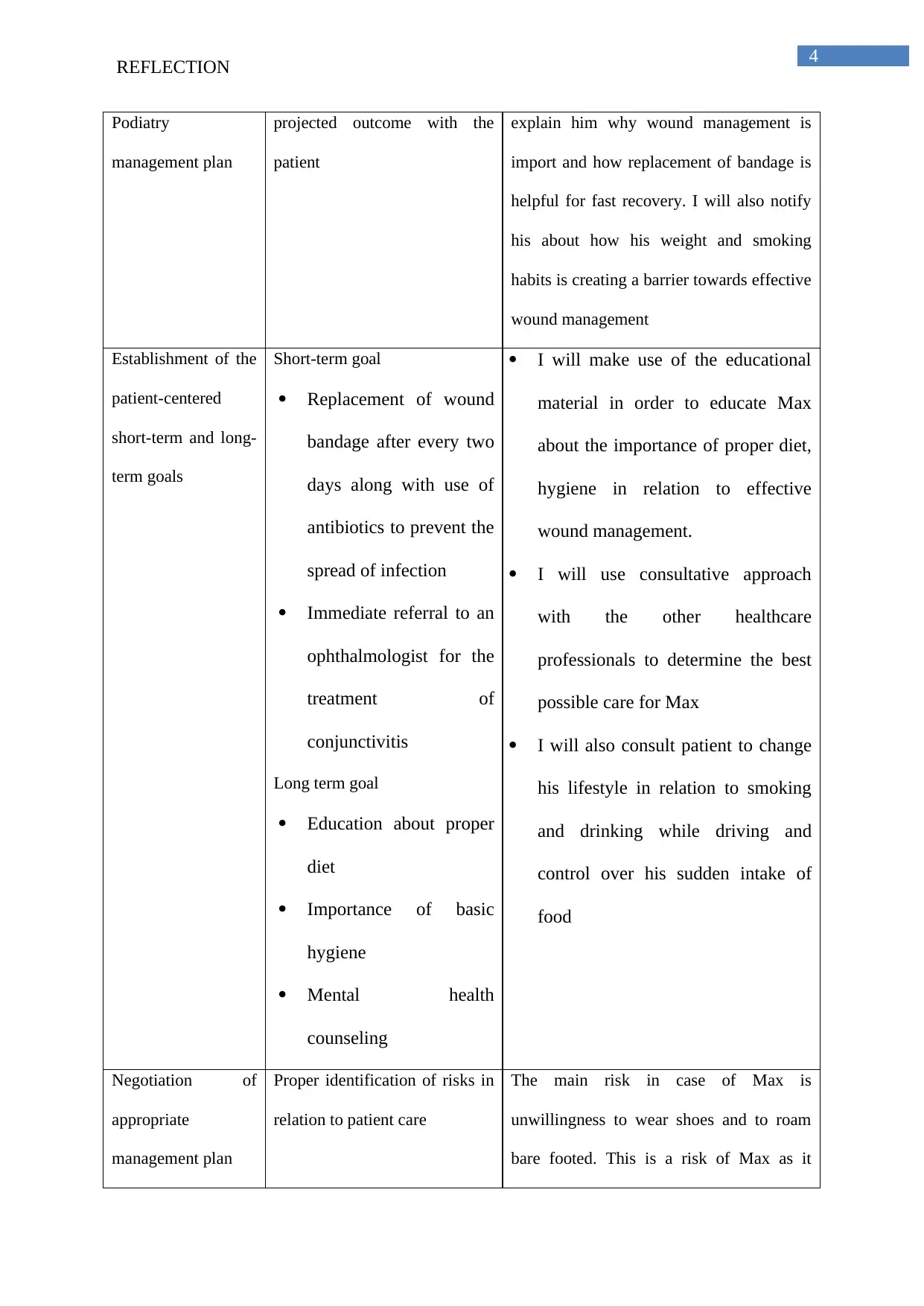
4
REFLECTION
Podiatry
management plan
projected outcome with the
patient
explain him why wound management is
import and how replacement of bandage is
helpful for fast recovery. I will also notify
his about how his weight and smoking
habits is creating a barrier towards effective
wound management
Establishment of the
patient-centered
short-term and long-
term goals
Short-term goal
Replacement of wound
bandage after every two
days along with use of
antibiotics to prevent the
spread of infection
Immediate referral to an
ophthalmologist for the
treatment of
conjunctivitis
Long term goal
Education about proper
diet
Importance of basic
hygiene
Mental health
counseling
I will make use of the educational
material in order to educate Max
about the importance of proper diet,
hygiene in relation to effective
wound management.
I will use consultative approach
with the other healthcare
professionals to determine the best
possible care for Max
I will also consult patient to change
his lifestyle in relation to smoking
and drinking while driving and
control over his sudden intake of
food
Negotiation of
appropriate
management plan
Proper identification of risks in
relation to patient care
The main risk in case of Max is
unwillingness to wear shoes and to roam
bare footed. This is a risk of Max as it
REFLECTION
Podiatry
management plan
projected outcome with the
patient
explain him why wound management is
import and how replacement of bandage is
helpful for fast recovery. I will also notify
his about how his weight and smoking
habits is creating a barrier towards effective
wound management
Establishment of the
patient-centered
short-term and long-
term goals
Short-term goal
Replacement of wound
bandage after every two
days along with use of
antibiotics to prevent the
spread of infection
Immediate referral to an
ophthalmologist for the
treatment of
conjunctivitis
Long term goal
Education about proper
diet
Importance of basic
hygiene
Mental health
counseling
I will make use of the educational
material in order to educate Max
about the importance of proper diet,
hygiene in relation to effective
wound management.
I will use consultative approach
with the other healthcare
professionals to determine the best
possible care for Max
I will also consult patient to change
his lifestyle in relation to smoking
and drinking while driving and
control over his sudden intake of
food
Negotiation of
appropriate
management plan
Proper identification of risks in
relation to patient care
The main risk in case of Max is
unwillingness to wear shoes and to roam
bare footed. This is a risk of Max as it
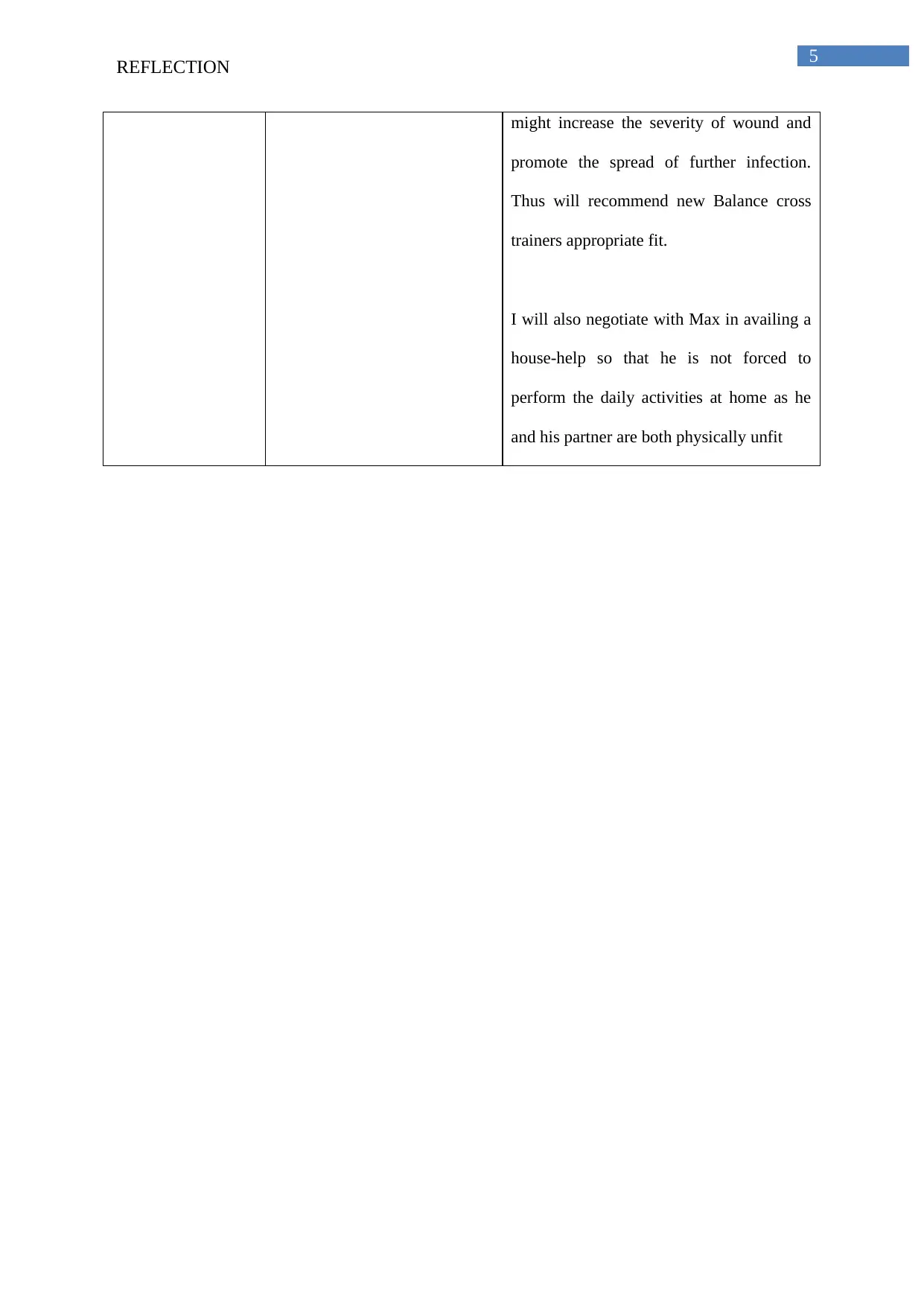
5
REFLECTION
might increase the severity of wound and
promote the spread of further infection.
Thus will recommend new Balance cross
trainers appropriate fit.
I will also negotiate with Max in availing a
house-help so that he is not forced to
perform the daily activities at home as he
and his partner are both physically unfit
REFLECTION
might increase the severity of wound and
promote the spread of further infection.
Thus will recommend new Balance cross
trainers appropriate fit.
I will also negotiate with Max in availing a
house-help so that he is not forced to
perform the daily activities at home as he
and his partner are both physically unfit
⊘ This is a preview!⊘
Do you want full access?
Subscribe today to unlock all pages.

Trusted by 1+ million students worldwide
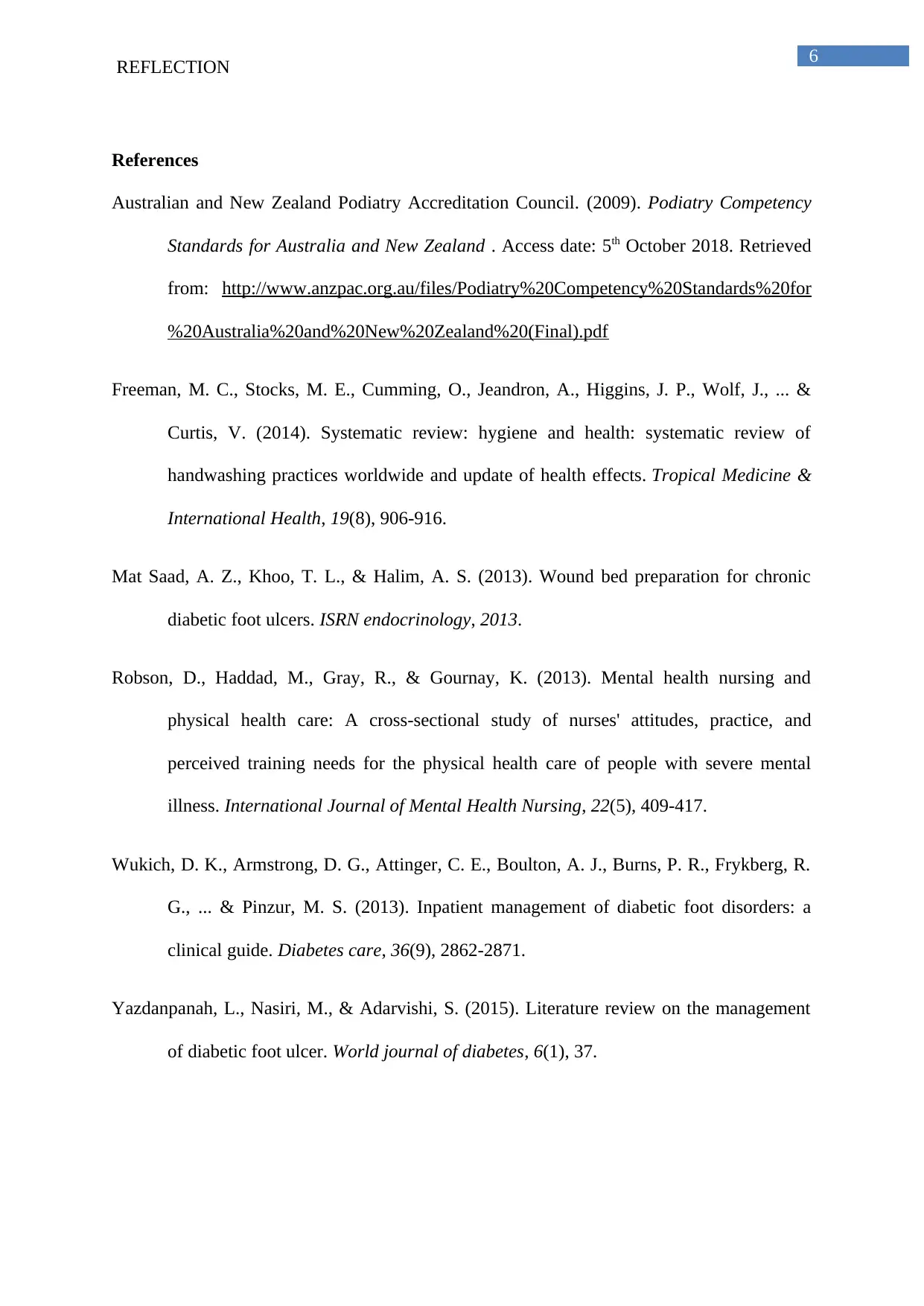
6
REFLECTION
References
Australian and New Zealand Podiatry Accreditation Council. (2009). Podiatry Competency
Standards for Australia and New Zealand . Access date: 5th October 2018. Retrieved
from: http://www.anzpac.org.au/files/Podiatry%20Competency%20Standards%20for
%20Australia%20and%20New%20Zealand%20(Final).pdf
Freeman, M. C., Stocks, M. E., Cumming, O., Jeandron, A., Higgins, J. P., Wolf, J., ... &
Curtis, V. (2014). Systematic review: hygiene and health: systematic review of
handwashing practices worldwide and update of health effects. Tropical Medicine &
International Health, 19(8), 906-916.
Mat Saad, A. Z., Khoo, T. L., & Halim, A. S. (2013). Wound bed preparation for chronic
diabetic foot ulcers. ISRN endocrinology, 2013.
Robson, D., Haddad, M., Gray, R., & Gournay, K. (2013). Mental health nursing and
physical health care: A cross‐sectional study of nurses' attitudes, practice, and
perceived training needs for the physical health care of people with severe mental
illness. International Journal of Mental Health Nursing, 22(5), 409-417.
Wukich, D. K., Armstrong, D. G., Attinger, C. E., Boulton, A. J., Burns, P. R., Frykberg, R.
G., ... & Pinzur, M. S. (2013). Inpatient management of diabetic foot disorders: a
clinical guide. Diabetes care, 36(9), 2862-2871.
Yazdanpanah, L., Nasiri, M., & Adarvishi, S. (2015). Literature review on the management
of diabetic foot ulcer. World journal of diabetes, 6(1), 37.
REFLECTION
References
Australian and New Zealand Podiatry Accreditation Council. (2009). Podiatry Competency
Standards for Australia and New Zealand . Access date: 5th October 2018. Retrieved
from: http://www.anzpac.org.au/files/Podiatry%20Competency%20Standards%20for
%20Australia%20and%20New%20Zealand%20(Final).pdf
Freeman, M. C., Stocks, M. E., Cumming, O., Jeandron, A., Higgins, J. P., Wolf, J., ... &
Curtis, V. (2014). Systematic review: hygiene and health: systematic review of
handwashing practices worldwide and update of health effects. Tropical Medicine &
International Health, 19(8), 906-916.
Mat Saad, A. Z., Khoo, T. L., & Halim, A. S. (2013). Wound bed preparation for chronic
diabetic foot ulcers. ISRN endocrinology, 2013.
Robson, D., Haddad, M., Gray, R., & Gournay, K. (2013). Mental health nursing and
physical health care: A cross‐sectional study of nurses' attitudes, practice, and
perceived training needs for the physical health care of people with severe mental
illness. International Journal of Mental Health Nursing, 22(5), 409-417.
Wukich, D. K., Armstrong, D. G., Attinger, C. E., Boulton, A. J., Burns, P. R., Frykberg, R.
G., ... & Pinzur, M. S. (2013). Inpatient management of diabetic foot disorders: a
clinical guide. Diabetes care, 36(9), 2862-2871.
Yazdanpanah, L., Nasiri, M., & Adarvishi, S. (2015). Literature review on the management
of diabetic foot ulcer. World journal of diabetes, 6(1), 37.
1 out of 7
Your All-in-One AI-Powered Toolkit for Academic Success.
+13062052269
info@desklib.com
Available 24*7 on WhatsApp / Email
![[object Object]](/_next/static/media/star-bottom.7253800d.svg)
Unlock your academic potential
Copyright © 2020–2025 A2Z Services. All Rights Reserved. Developed and managed by ZUCOL.


